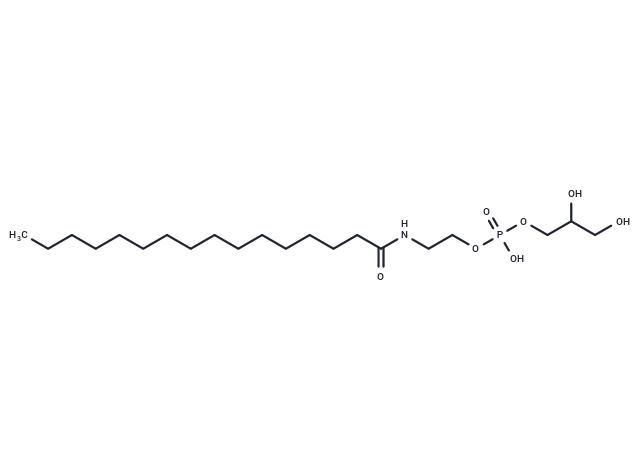 您的购物车当前为空
您的购物车当前为空
Glycerophospho-N-Palmitoyl Ethanolamine
一键复制产品信息N-Acylated ethanolamines (NAE) are naturally-occurring lipids that have diverse bioactivities. For example, arachidonoyl ethanolamide (AEA) is an endogenous neurotransmitter that evokes cellular responses by activating the cannabinoid receptors, central cannabinoid (CB1) and peripheral cannabinoid (CB2). The different types of NAE are derived from glycerophospho-linked precursors by the activity of glycerophosphodiesterase 1 (GDE1). Glycerophospho-N-palmitoyl ethanolamine (GP-NPEA) is the metabolic precursor of palmitoyl ethanolamide (PEA). PEA is an endogenous cannabinoid found in brain, liver, and other mammalian tissues, that has potent anti-inflammatory activity in vivo. PEA has low affinity for peripheral cannabinoid (CB2) and no appreciable affinity for central cannabinoid (CB1), suggesting that its efficacy is through a different receptor.

Glycerophospho-N-Palmitoyl Ethanolamine
一键复制产品信息N-Acylated ethanolamines (NAE) are naturally-occurring lipids that have diverse bioactivities. For example, arachidonoyl ethanolamide (AEA) is an endogenous neurotransmitter that evokes cellular responses by activating the cannabinoid receptors, central cannabinoid (CB1) and peripheral cannabinoid (CB2). The different types of NAE are derived from glycerophospho-linked precursors by the activity of glycerophosphodiesterase 1 (GDE1). Glycerophospho-N-palmitoyl ethanolamine (GP-NPEA) is the metabolic precursor of palmitoyl ethanolamide (PEA). PEA is an endogenous cannabinoid found in brain, liver, and other mammalian tissues, that has potent anti-inflammatory activity in vivo. PEA has low affinity for peripheral cannabinoid (CB2) and no appreciable affinity for central cannabinoid (CB1), suggesting that its efficacy is through a different receptor.
| 规格 | 价格 | 库存 | 数量 |
|---|---|---|---|
| 1 mg | ¥ 2,130 | 35日内发货 | |
| 5 mg | ¥ 9,350 | 35日内发货 | |
| 10 mg | ¥ 16,300 | 35日内发货 |
Glycerophospho-N-Palmitoyl Ethanolamine 相关产品
产品介绍
| 产品描述 | N-Acylated ethanolamines (NAE) are naturally-occurring lipids that have diverse bioactivities. For example, arachidonoyl ethanolamide (AEA) is an endogenous neurotransmitter that evokes cellular responses by activating the cannabinoid receptors, central cannabinoid (CB1) and peripheral cannabinoid (CB2). The different types of NAE are derived from glycerophospho-linked precursors by the activity of glycerophosphodiesterase 1 (GDE1). Glycerophospho-N-palmitoyl ethanolamine (GP-NPEA) is the metabolic precursor of palmitoyl ethanolamide (PEA). PEA is an endogenous cannabinoid found in brain, liver, and other mammalian tissues, that has potent anti-inflammatory activity in vivo. PEA has low affinity for peripheral cannabinoid (CB2) and no appreciable affinity for central cannabinoid (CB1), suggesting that its efficacy is through a different receptor. |
| 分子量 | 453.557 |
| 分子式 | C21H44NO7P |
| CAS No. | 100575-09-5 |
| 存储 | Powder: -20°C for 3 years | In solvent: -80°C for 1 year | Shipping with blue ice/Shipping at ambient temperature. | ||||||||||||||||||||
| 溶解度信息 | PBS (pH 7.2): 5 mg/mL (11.02 mM), Sonication is recommended. | ||||||||||||||||||||
溶液配制表 | |||||||||||||||||||||
PBS (pH 7.2)
| |||||||||||||||||||||





 还可以
还可以

 |
|
评论内容